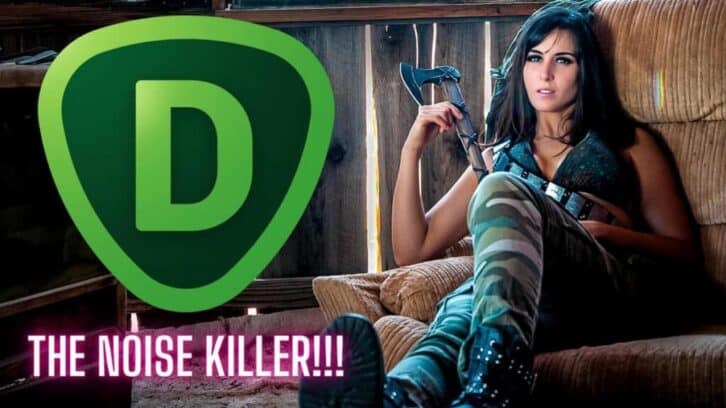
Welcome to my Topaz DeNoise AI Review Version 3.7
Like nearly every photographer out there we have all heard of someone raving about Topaz Labs DeNoise AI so I thought it was about time I updated my DeNoise AI Review. So let’s take a good in depth look at it via the photographs and videos I have for you below.
Probably the most important detail of any editing software after the results of course is how much is it going to cost you. So let’s have a look at that first.
DeNoise AI Price.
At the time of doing this DeNoise AI Review it was retailoing around $79.99 and with that you get a years worth of free updates. After the year you have to upgrade to get another years worth of updates if you want them.
So is the years update worth it?
Well, the last real update was 9 months ago now which was Version 3.7.0 even though we are now on Version 3.7.2 but there where no serious improvements from version 3.7.0 just a few slight performance improvements, fixes and bug fixes. So, I generally say the years worth of updates is generally not great value for money unless you go for the Image Quality Bundle which also includes Sharpen AI and Gigapixel AI, in those updates you generally get better value for money.
Is DeNoise AI worth its price?
Well, Yes, I think it is but before you jump into buying it you should also have a serious look at the other alternatives that give as good if not better results for around the same price and in some cases considerably less.
Software like DxO PureRaw 3, On1 NoNoise AI 2023 or Noiseless AI from Luminar Neo are all serious contenders now for noise reduction software. I have reviews on all of them in the Software tips section in the main menu above if you would like to know more about them.
For example you can read my ON1 NoNoise AI 2023 vs DeNoise AI noise shoot out here or watch it in my video below where I directly compare them and the results surprisingly give a very clear winner.
My Topaz DeNoise Conclusion…
A quick conclusion for those of you that don’t want to read the full review or watch the DeNoise AI Review video below…
- Topaz DeNoise AI is without doubt a good bit of noise reduction software but I think it’s slipping down the ranks now and is no longer the best Noise Reduction software out there. With DxO DeepPrime XD, ON1 NoNoise AI 2023 and Luminar Neo Noiseless AI all fighting for top spot with DeNoise AI has and is now slipping down the rankings of noise reduction software. I no longer use DeNoise AI myself in either my personal or professional workflow. In saying that it could still be right for you though and in the end of the day that’s all that matters.
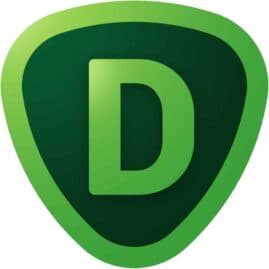
Topaz DeNoise AI review and who actually needs it?
I am not one of those photographers that would use something like DeNoise AI very regularly. I normally don’t shoot with high ISO’s and my exposures are usually pretty spot on so I normally wouldn’t have that much noise in my images.
When I do have noise in my images I know I really need something like DeNoise AI and in those moments it’s worth it’s weight in gold. That’s why I said at the start that price should only come second to results.
So who is Topaz DeNoise AI software for?
DeNoise AI is very popular with wildlife photographers, astro photographers, macro photographers, wedding photographers and sports photographers. All these photographers have one thing in common they often need to boost their ISO to get the shot they want.
For example you might be trying to photograph a fast moving subject in low light levels so the only option you have to freeze the subject is to boost your ISO which is going to give you more noise.
Now that’s not to say landscape photographers and other genres of photography don’t use DeNoise AI as they do but just not as frequently. In honesty I think every photographer could use DeNoise AI or NoNoise AI 2023 from time to time.
You can see my Topaz DeNoise AI review on YouTube below if you would like to see the software in action.
Topaz DeNoise AI Review
The best way to test any product like this is to just take a few photographs at incredibly high ISO’s and then look at the end results. So I am gonna go grab my camera now and shoot a few photographs at ISO 12,800 and post the results below.
This image was shot on the Nikon Z7ii at ISO 12,800 F8 1/100th SS handheld. Before popping it into DeNoise AI I bumped up the exposure by +0.4 and the shadows by +25 just to give it a slightly more realistic feel to the shot as lets face it you will nearly always need to boost your shadows and that’s going to increase the noise in your image yet again, so we are now hopefully dealing with a worst case scenario in this shot.
I picked a camera for my subject as it has a load of different textures, the colours and the details in the camera cage and rosewood handle are great for showing up noise and for highlighting details also.
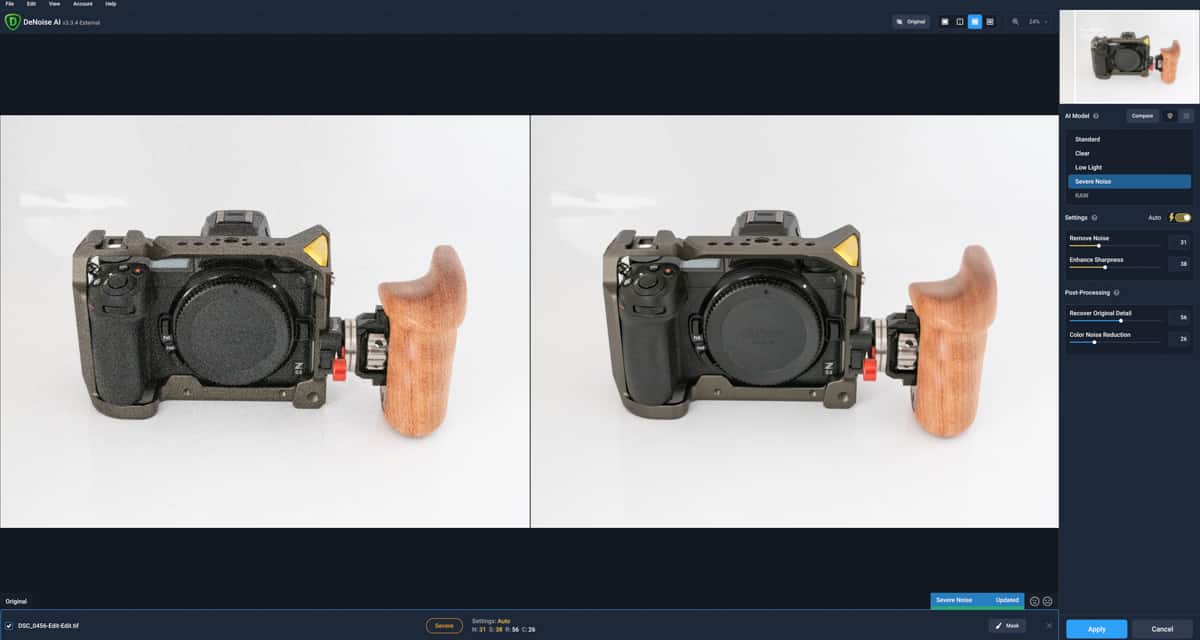
After opening the image in DeNoise AI the software automatically calculates not only the best algorithm for the image to reduce the noise but it also automatically applies the right amount of “Remove Noise” and “Enhance Sharpness” tweaking to your photograph. Giving a near instantly improved image, ok, instantly might be a bit of a stretch but it happens in a few seconds once you zoom in.
The trick to Noise reduction is to zoom into the trouble spots and get to 80% or 100% magnification as the area to be edited for previewing will be a lot smaller it edits it faster then. I always start at about 100% get the effect I want and then zoom out a bit and check the rest of the image or simply “Apply” the DeNoise AI edit to the save the edit.
Now obviously it’s going to be hard to see any massive difference in the two images above so I have a cropped version below which zooms into 100% on the camera controls where we have some different textures for DeNoise AI to try and recover. The grip, buttons and the metal cage are all different textures and colours.
I was pleasantly surprised with the results and for any software to work this well is fantastic. AI editing and photography software in general has been ground breaking for photography as it’s helping us to capture images that would have been impossible years ago.
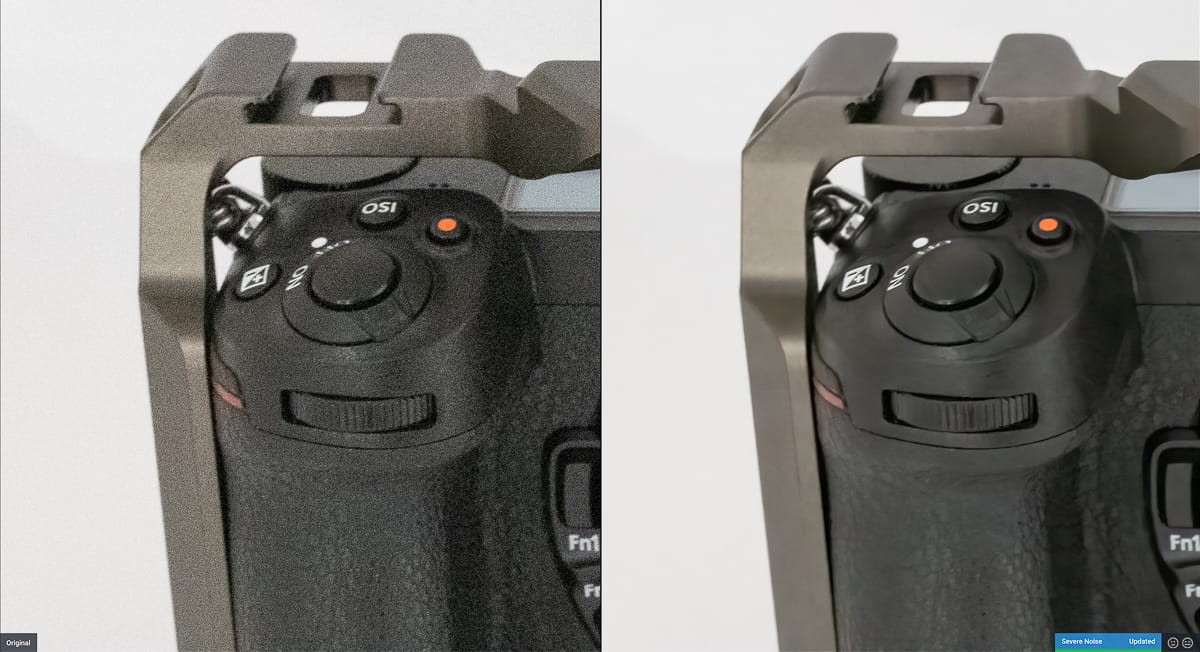
Now that’s a big difference but the one thing I would say is here is I think the edited file is fairly soft and yes I know I am sounding like a broken record here but ON1 NoNoise AI 2023 doesn’t have that issue and even if it does give you a slightly soft result you still have Tack Sharp AI built in to sharpen up the image nicely for you.
BTW if you are looking at buying any of the Topaz Labs AI editing software like DeNoise AI, Sharpen AI or Gigapixel AI then I highly recommend you go for the Image Quality bundle as it includes all three of these amazing bits of editing software for a great price. Click here to read more about the Image Quality Bundle.
From my experiences Topaz Photo AI just doesn’t work as well as their stand alone apps and it also has fewer controls. Crazily you can buy ON1 Photo Raw 2023 (review here) which is a full and detailed editing platform like Lightroom and it also includes NoNoise AI, Tack Sharp AI, Resize AI, Portrait AI and all the usual editing controls for cheaper than the Photo AI or the Image Quality Bundle.

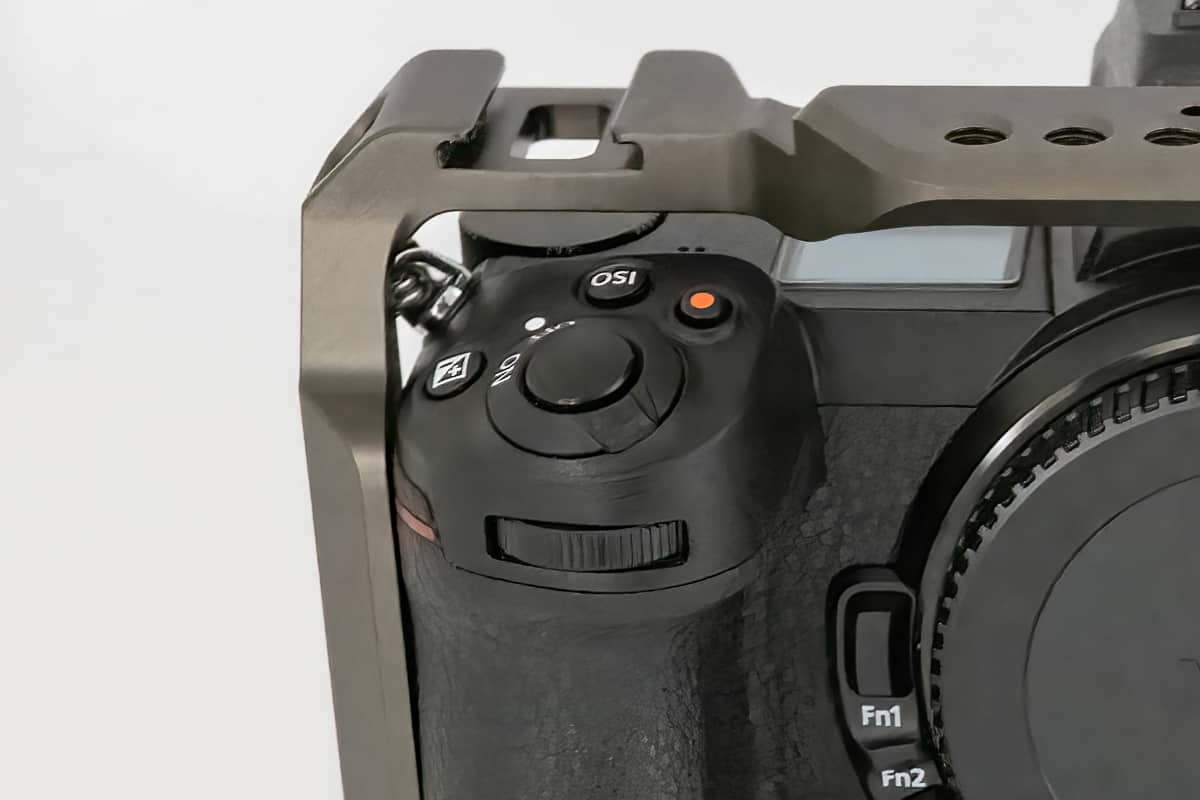
The above shots are zoomed in at 100% with the top image being the original file and the second image being the edited file which was edited in DeNoise AI first and then sharpened it in Sharpen AI to give the image back a bit of sharpness. Is it perfect no it’s not but it is incredibly close to it.
Looking at the end results at 50% magnification you would be struggling to find anything wrong with the shot. Now again let me just say this was ISO 12,800 and I boosted the shadows and exposure before I processed the the Image in DeNoise AI.
I have a video review below also of Topaz DeNoise AI vs Topaz Photo AI where I look at two photographs in both applications to see which one is really better.
Operating System Requirements For Topaz DeNoise AI
Internet Access
All current Topaz Labs apps require an internet connection for user authentication and/or AI model downloading & updates.
| Windows | 7*, 8*, 10, 11 (64 bit only) Windows 7 and 8 are not supported but may function for some users |
| Mac | 10.13 High Sierra and above DeNoise AI v3.4 and higher requires macOS 10.14 or higher. Sharpen AI v4.0 and higher requires macOS 10.14 or higher. |
Big Sur and Monterey
DeNoise AI is currently compatible with and supported on Big Sur and Monterey. This app is not yet M1 native, but will automatically run through your Rosetta 2 emulator if you are using an M1 device.
Apple Silicon/M1
M1, M1 Pro and M1 Max chips have been tested with Sharpen AI.
The DeNoise AI plugin is M1 native and will work natively with Photoshop 22.3 and above, which are M1 native Photoshop versions. Our other plugins will not show up on Photoshop 22.3 or higher unless you run Photoshop through Rosetta 2.
To manually force Photoshop to run through Rosetta 2, right-click your Photoshop application icon, select the Get Info menu option, and look for the “Run with Rosetta 2” checkbox in the Get Info panel. If you use the suite of Topaz applications as Photoshop plugins, you will have the smoothest plugin experience on an M1 device by keeping Photoshop running through Rosetta 2 for the time being regardless of which version of Photoshop you are using.
Tablets & iPads
Our photo applications do not currently run on iOS or Android devices. A laptop or desktop computer is required.
Linux
We currently do not support Linux-based operating systems.
*Windows 7 and Windows 8
As of Jan 14, 2020, we no longer support Windows 7 and 8 for our application updates. While we cannot support a manufacturer’s unsupported operating system, our photo applications may still function on Windows 7 devices provided other hardware is compatible. Please note that we cannot guarantee a Windows 7 operating system that works with one version of our applications will continue to work with future versions of our applications.
Hardware Minimum Requirements for DeNoise AI
| Processor (CPU) | Intel i3 or AMD Ryzen 3 equivalent or above (3.0 GHz and above) AVX Instructions required. |
|
| System Memory (RAM) | 8GB (16GB and higher is recommended for improved performance) | |
| Graphics Card (GPU) | OpenGL 3.3 or higher required. Nvidia GTX 740 or AMD Radeon 5870 (higher series graphics cards recommended) |
|
| Dedicated Graphics Memory (VRAM) | 2 GB (6GB or more for optimum performance) | |
| Display (Monitor) | At least 1024×768 |
Special Hardware Considerations For Image Apps
The specifications listed above are minimum requirements to operate the software. More robust hardware will improve overall performance and processing speed. Your computer’s ability to process an image may be affected by the size of the file itself, and a large enough file can exceed the resources of a minimally equipped computer and cause errant behavior.
Some computers without a dedicated graphics card may function but errant behavior should be expected. A sufficient dedicated graphics card with OpenGL 3.3 and at least 2 GB of VRAM is our minimum requirement to support the software on your device. We do not support Intel HD Graphics 4600 integrated graphics cards or lower in any configuration.
Graphics Drivers
Outdated graphics drivers may result in faulty performance. Drivers should be kept current through the GPU manufacturer’s website or provided software. Windows driver updates are rarely current and newer drivers may be available even when Windows says you are up to date. Our programs use the newest optimizations from both Nvidia and AMD whenever possible.
You can find more Topaz Labs reviews and my Topaz Labs Promo code here.
Topaz Labs congratulations on an good bit of software and I think an awful lot of the Wildlife, Astro, Wedding and sports photographers out there will be thanking you for years to come.
I have a few more photography editing software reviews below if you are interested in reading more about them…
Luminar… I have reviews of the Skylum range of photography editing software also Luminar Neo Discount Code and my full Luminar Neo Review Here.
ON1… Including my ON1 Photo Raw 2024 Review, ON1 Resize AI 2023, ON1 NoNoise AI 2023 vs DeNoise AI and check out my ON1 Promo code here for 20% off.
If you want to learn more about Photography in a nice relaxed enjoinment then why not then why not attend one of my photography workshops.
See you out there,
Kieran.
Topaz Labs DeNoise AI Review by Landscape Photography Ireland reviewed by Kieran Hayes.
